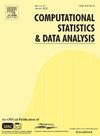应用于血迹模式分析的定向线性数据的狄利克特过程模型
IF 1.5
3区 数学
Q3 COMPUTER SCIENCE, INTERDISCIPLINARY APPLICATIONS
引用次数: 0
摘要
方向性数据需要专门的模型,因为其领域具有非欧几里得性质。当一个方向性变量与线性变量一起被观测时,对它们的依赖性建模又增加了一层复杂性。本文引入了一种贝叶斯非参数方法来分析方向线性数据。首先,对投影正态分布进行了扩展,以模拟线性变量和任意维度的方向变量的联合分布。新分布被称为半投影正态分布(SPN),可用作 Dirichlet 过程模型中的混合分布,从而获得一类更灵活的方向线性数据模型。然后,提出了一种条件反 Wishart 分布作为先验分布的一部分,以解决投影正态分布遗留下来的可识别性问题,并保持与 SPN 的共轭性。与半包高斯模型相比,SPN 混合模型在合成数据的聚类中表现出更优越的性能。实验表明,SPN 混合物模型有能力描述血迹模式。建立了一个具有 SPN 分布的分层 Dirichlet 过程模型,用于估算血迹模式在假定因果机制下的可能性,并将其用于分析法医血迹模式证据的似然比方法。本文章由计算机程序翻译,如有差异,请以英文原文为准。
A Dirichlet process model for directional-linear data with application to bloodstain pattern analysis
Directional data require specialized models because of the non-Euclidean nature of their domain. When a directional variable is observed jointly with linear variables, modeling their dependence adds an additional layer of complexity. A Bayesian nonparametric approach is introduced to analyze directional-linear data. Firstly, the projected normal distribution is extended to model the joint distribution of linear variables and a directional variable with arbitrary dimension projected from a higher-dimensional augmented multivariate normal distribution. The new distribution is called the semi-projected normal distribution (SPN) and can be used as the mixture distribution in a Dirichlet process model to obtain a more flexible class of models for directional-linear data. Then, a conditional inverse-Wishart distribution is proposed as part of the prior distribution to address an identifiability issue inherited from the projected normal and preserve conjugacy with the SPN. The SPN mixture model shows superior performance in clustering on synthetic data compared to the semi-wrapped Gaussian model. The experiments show the ability of the SPN mixture model to characterize bloodstain patterns. A hierarchical Dirichlet process model with the SPN distribution is built to estimate the likelihood of bloodstain patterns under a posited causal mechanism for use in a likelihood ratio approach to the analysis of forensic bloodstain pattern evidence.
求助全文
通过发布文献求助,成功后即可免费获取论文全文。
去求助
来源期刊

Computational Statistics & Data Analysis
数学-计算机:跨学科应用
CiteScore
3.70
自引率
5.60%
发文量
167
审稿时长
60 days
期刊介绍:
Computational Statistics and Data Analysis (CSDA), an Official Publication of the network Computational and Methodological Statistics (CMStatistics) and of the International Association for Statistical Computing (IASC), is an international journal dedicated to the dissemination of methodological research and applications in the areas of computational statistics and data analysis. The journal consists of four refereed sections which are divided into the following subject areas:
I) Computational Statistics - Manuscripts dealing with: 1) the explicit impact of computers on statistical methodology (e.g., Bayesian computing, bioinformatics,computer graphics, computer intensive inferential methods, data exploration, data mining, expert systems, heuristics, knowledge based systems, machine learning, neural networks, numerical and optimization methods, parallel computing, statistical databases, statistical systems), and 2) the development, evaluation and validation of statistical software and algorithms. Software and algorithms can be submitted with manuscripts and will be stored together with the online article.
II) Statistical Methodology for Data Analysis - Manuscripts dealing with novel and original data analytical strategies and methodologies applied in biostatistics (design and analytic methods for clinical trials, epidemiological studies, statistical genetics, or genetic/environmental interactions), chemometrics, classification, data exploration, density estimation, design of experiments, environmetrics, education, image analysis, marketing, model free data exploration, pattern recognition, psychometrics, statistical physics, image processing, robust procedures.
[...]
III) Special Applications - [...]
IV) Annals of Statistical Data Science [...]
 求助内容:
求助内容: 应助结果提醒方式:
应助结果提醒方式:


